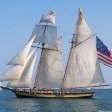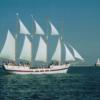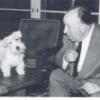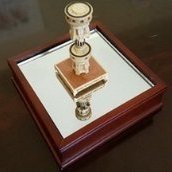MORE HANDBOOKS ARE ON THEIR WAY! We will let you know when they get here.
×
-
Posts
1,871 -
Joined
-
Last visited
Reputation Activity
-
 MEDDO got a reaction from mtaylor in Ancre Publications
MEDDO got a reaction from mtaylor in Ancre Publications
You should always watch Amazon as well. I was able to pick up a used copy of volume one of the 74 gun ship for only $16 a little bit ago .
-
 MEDDO got a reaction from piter56 in Halifax 1768 by MEDDO - FINISHED - Lauck Street Shipyard - 1/4" scale
MEDDO got a reaction from piter56 in Halifax 1768 by MEDDO - FINISHED - Lauck Street Shipyard - 1/4" scale
Small update. Finished the bits so next up is the rudder.
-
 MEDDO got a reaction from piter56 in Halifax 1768 by MEDDO - FINISHED - Lauck Street Shipyard - 1/4" scale
MEDDO got a reaction from piter56 in Halifax 1768 by MEDDO - FINISHED - Lauck Street Shipyard - 1/4" scale
So I have been away for a while. My practice went through a massive expansion/contraction/expansion etc etc. Ended up working way too much. I also got somewhat distracted for the last few months building a kayak. I am finishing that up and am cleaning up the shipyard so I can start working again. Here is a picture of where I am now.
I like the new site design and wanted to see if I remembered how to get pictures uploaded etc.
-
 MEDDO got a reaction from RGL in Halifax 1768 by MEDDO - FINISHED - Lauck Street Shipyard - 1/4" scale
MEDDO got a reaction from RGL in Halifax 1768 by MEDDO - FINISHED - Lauck Street Shipyard - 1/4" scale
I been able to get a few more steps done.
Catheads. Weird the instructions only had a single layer for the catheads. Every picture and the plans had these double thick so I had to freehand cut out 2 more then drill the sheave holes in them. They seem to have come out fairly well.
Caprails to cover the frame ends.
Railing supports. These were pretty hard to fit as the pre-drilled/milled holes they fit into in the cap rail were way too small. I didn't notice this until the cap rails were already installed. This made opening them up very difficult. After a bunch of micro scalpel work they sit in pretty well.
Railings. These were 2 layers. The first layer had holes in it to attach to the posts. A top finish layer was then glued on top of it to make a smooth run down the rail.
Here is the state of the build with a few pieces of deck furniture dry fitted on.
-
 MEDDO reacted to jdbondy in Pride of Baltimore II by jdbondy - FINISHED - Model Shipways - 1:64 scale
MEDDO reacted to jdbondy in Pride of Baltimore II by jdbondy - FINISHED - Model Shipways - 1:64 scale
Let’s talk about ship’s boats. In particular, Chasseur, the lapstrake planked ship’s boat on board the Pride of Baltimore 2. This is what she looks like in real life. Before I was ready to jump back into the pool of working on the big hull of Pride 2, I decided to re-examine what I thought I would do with the ship’s boat. When I started the model, I had been thinking that I would never be able to outfit such a small model boat (less than 2 inches long) with all the details she was worthy of, like a false keel, ribs, stringers, thwarts, etc., and so I pictured building the bread-and-butter hull out of the parts provided by the model, sanding it smooth, painting it, and covering it with a tied-down cloth cover so that no one would see that it was an unfinished interior.
2 things changed my mind. One was seeing the interior of the actual boat when we visited Pride 2 in July 2009, and seeing how beautiful all that detail was. The second was realizing that on the practicum I had bought for the Pride 2 from Lauck Street, there was a particular segment devoted to the building of ship’s boats, in particular ones fashioned from bread-and-butter technique (as opposed to building the hull up around a plug, a more accurate and cerebral technique). It made me realize that I was probably capable of adding more detail than I thought.
I don’t have any pictures of the boat before this image, which shows that the false keel and ribs have been added, and part of the flooring is installed. Of course, what had to be done to get to this point was to use the drum sander attachment of my Dremel to grind off all the interior ridges of wood left behind by the bread-and-butter technique, then use sanding paper or files to reach all the nooks and crannies in the bow and stern of the model. I never reached the degree of sharpness in those areas that I desired, but at some point I decided to just move along. The interior surface was then stained. I did not put on a topcoat because I knew I had to glue the ribs in place, and any coatings would interfere with that.
The ribs were an interesting step. At this time in my re-emerging modeling career, I did not think about using anything other than basswood. And I didn’t have any fancy table saws or thickness sanders. So the strips of wood were all hand-cut and hand-sanded down to a thickness that just seemed like it was right. They were probably between 1/32” and 1/64” in thickness and about 1/16” in width. They were super-pliable without running the risk of creasing them. Gluing them in place was purely a rack-of-eye kind of thing, making sure to install them vertically and perpendicular to the keel. The first ribs were placed in the midships, and all subsequent ribs were set parallel to those. The ribs were put in so that they bridged the boat completely from gunwale to gunwale, and then later the central portions were cut out to accommodate the false keel.
This picture shows that the floorboards have been finished. The sheer has been cut to its proper profile, and two internal strakes have been added as well as a toprail. The oarlocks were very carefully cut out and reinforced with a thin veneer of wood surrounding each one. A lock for the tiller has also been cut into the stern rail.
I think that if I had found my source of boxwood and pearwood by this time, I would have done these details with those woods. But I think things turned out well, and the grain of the basswood is not distracting.
You can faintly see the layers of the bread-and-butter buildup technique in the transom.
The interior is now all stained out. A breasthook has been added.
You can tell on these images how tough it was to get into the corners of the bow and stern. But I was very pleased with the overall effect. The roughness shown in the images disappears at scale, and when viewed in close up I think it gives the interior a rustic, Wooden Boat School-type appearance. I think it was about this time that I purchased a macro lens for my camera (Nikon D80). That thing gets plenty of use!!
Staining out the area of the gunwales and rubrails. A second rubrail would be applied. Again evident is the horizontal lines of the bread-and-butter buildup technique.
Those hull lines disappear once the hull is fully primed and painted. The white paint on the hull was airbrushed on. The seats and thwarts are made from styrene sheets.
Finally, I constructed 4 oars as well as a rudder and a tiller. The blades of the oars are admittedly oversized. I could not bring myself to hand-paint or otherwise apply the ship’s name to the transom. Call me a coward!
Next time, back to the big boat.
-
 MEDDO reacted to xken in USS Constitution by xken - Model Shipways - Scale 1:76.8
MEDDO reacted to xken in USS Constitution by xken - Model Shipways - Scale 1:76.8
I have moved on to the topmast shroud lines; pretty much the same with the exception of the sheer poles which I used 1/32" rod which does not bend under shroud line tautness when tightening. The staves at the top were added and I used clamping tweezers to hold the lines flat while glue set. I also used a threaded line as a reference point while tightening the shrouds so as not to pull the masts out of alignment. I made sure the mast were tightly fitted at the deck when fitting them to the deck; however the top masts are indexed at the top and are more subject to moving when adding the shroud lines.
I am also adding the top mast stay lines while also working on the ratlines. This way I can move back and forth while waiting for glue to set.
Shroud lines in place; no staining until the end of the rigging is accomplished for all shrouds and ratlines.
Now back to rigging.
-
 MEDDO reacted to rafine in Halifax by rafine - FINISHED - The Lumberyard - 1:48 - semi-scratch schooner
MEDDO reacted to rafine in Halifax by rafine - FINISHED - The Lumberyard - 1:48 - semi-scratch schooner
Thanks so much Michael, Denis, Anja and the "likes. Appreciated, as always.
Michael, I continue to look forward to further progress on your Halifax.
Bob
-
 MEDDO reacted to DocBlake in Halifax by rafine - FINISHED - The Lumberyard - 1:48 - semi-scratch schooner
MEDDO reacted to DocBlake in Halifax by rafine - FINISHED - The Lumberyard - 1:48 - semi-scratch schooner
Very nice work, Bob. I'll watch this build with interest!
I'm building AL's "Independence" which is a colonial schooner like "Halifax". I'm planning to use the Halifax rigging plan from my Lauck Street Halifax kit to rig the Independence. The problem is that there is no belaying diagram. Are you aware of a belaying plan for Halifax?
-
 MEDDO reacted to jdbondy in Pride of Baltimore II by jdbondy - FINISHED - Model Shipways - 1:64 scale
MEDDO reacted to jdbondy in Pride of Baltimore II by jdbondy - FINISHED - Model Shipways - 1:64 scale
In 2008, when my older son was about 8 years old, the model finally came off the shelf. The hull and deck were fully planked, and it was for the most part completely painted. Coamings for the deck furniture were also in place and painted. The mast steps were also already in place. I think our story will start with the (mostly) assembled hull and proceed with bringing it up to date, installing deck furniture, creation of a base and ways, and finally getting to what I am now working on, the rigging.
This first picture is how she looked after emerging from cryogenic storage. As mentioned, the deck has been planked up, and the bulwarks and rail are in place. I will always just have to accept that the curve of the rail is abnormally bumpy, and does not have a smooth flow to it. This is especially true in the area of the foremast pin rails.
Other things worth noting about the model: the interior surfaces of the bulwark planking is painted a relatively bright yellow and not a cream color. This would be redone. Within the coaming for the midships cabintop, pieces of wood protrude that were used for clamping the hull in a vise back when it was being planked. These would of course be removed. I made the temporary cradle out of scrap and out of some of the wood sheet that defined one of the bulkheads. The fancy pieces of the transom have not yet been installed.
This showed the strip planking of the transom, which would be removed and replaced with a sheet of basswood. The stern knees would also be removed since I had painted them, while in real life the stern knees are not painted.
Back before the model went into hiding, I spent a lot of time building the aft cabintop, and was very proud of it. Even so, I know I could do a better job if I were building it today. I could have elected to rebuild it and make it more accurate given what I learned about the ship from photographing her in Boston in July 2009 (more below), but I felt that I would leave it as a testimony to my modeling skills as they were in the late 1990s.
This is how things stood in the spring of 2008. I was very excited to be able to get back to work on the model. Our boys were old enough that we felt we were not constantly under water looking after them, and in addition, my wife had agreed to let me take over the guest room and set it up as my workshop!
During this same time, I also found Bob Hunt’s Lauck Street Shipyard, and was happy to see that one of his courses had to do with building the Pride of Baltimore 2. I sent off for the practicum, and I still refer to it from time to time.
Fast forward to April 2010. In that span of time, relevant things that happened including getting to see the actual Pride of Baltimore 2 in Boston. I thoroughly bored my wife and kids as I wandered all around the ship, taking pictures of anything I thought might be important. Captain Jan Miles was not there but the crew was very helpful. At this time, my older son was 9 years old (now 17!).
During that time I also went to my first NRG convention, in Annapolis, MD. Being at the meeting and being around other people who were passionate about model ship building really galvanized my motivation to get working on the model more consistently.
I also filled this time by building the ships boat. This was made a lot easier by going through the practicum about how to build ships boats. It was a nice, small project that enabled me to get back into the swing of things. I will cover that in a later post.
Back to the big boat: this image shows that I have repainted the starboard bulwarks using a cream color that has far less yellow. Matching the color was greatly helped by having photos of the actual boat. There are pieces of cardstock that are protecting the planking while the repainting is done. I do remember being very happy how clean the repainting turned out.
This is an inboard view of the port bulwarks where they meet the taffrail. I have stripped the planking from the taffrail and removed the stern knees. There is a strip of bulwarks planking under the stained rail that is unpainted; it was a shim that was put in to fill the gap created by the rail as it rises to meet the taffrail.
This is an outboard view of the same area. I don’t know why it felt so intimidating, but that fancy piece caused me a lot of worry as to how I would go about creating that piece. Plus it had to be beveled on its inboard surface to accept the transom planking. Fortunately, the piece of wood used was quite thin, and it was easy to get it to bend to conform to the planking.
While at the NRG meeting in Annapolis, I got the idea of putting my model through one of our CT scanners at work. This would lead to publication of an article about using CT scanning to study historical ship models, including 4 of the historic models in the Rogers collection at the USNA museum. Maybe that explains the big time gap in my photo documentation! But I digress…
I think my next post will be about the ship's boat.
-
 MEDDO got a reaction from mtaylor in Halifax 1768 by MEDDO - FINISHED - Lauck Street Shipyard - 1/4" scale
MEDDO got a reaction from mtaylor in Halifax 1768 by MEDDO - FINISHED - Lauck Street Shipyard - 1/4" scale
Thank you Steve. I agree the way the instructions have you plank the deck is strange to me but I guess everyone has their own preferences/aesthetic reasons for doing things.
Dave: I think I am probably not going to rig her at this time. I cannot say that would never change. Getting the standing rigging up I think would be pretty doable but the running lines and where they end up/belay to is a mystery I haven't looked into.
I think it was Bob (username Rafine) who has built this kit in the past and rigged her. He is also now just getting going on the Lumberyards version. He might be able to enlighten us a bit.
-
 MEDDO reacted to Martin W in Halifax by rafine - FINISHED - The Lumberyard - 1:48 - semi-scratch schooner
MEDDO reacted to Martin W in Halifax by rafine - FINISHED - The Lumberyard - 1:48 - semi-scratch schooner
Hi Bob -- Well, I've just gotten to your new build, and find that the theater has already gotten pretty crowded with your fan base!
I'm really intrigued by this build, since I've increasingly begun to feel frustrated with the 1:64 scale. My eyes have never been great, but even more it's the pieces (not me!) that are all just too small to get much detail on. I look forward to seeing how a skilled and experienced builder like you handles this build (kit/non-kit, whatever).
Cheers,
Martin
-
 MEDDO got a reaction from Elijah in Halifax by rafine - FINISHED - The Lumberyard - 1:48 - semi-scratch schooner
MEDDO got a reaction from Elijah in Halifax by rafine - FINISHED - The Lumberyard - 1:48 - semi-scratch schooner
Very nice. Looking at the figurehead on mine I wish I had the forethought to do this prior to proceeding.
-
 MEDDO got a reaction from Elijah in Halifax by rafine - FINISHED - The Lumberyard - 1:48 - semi-scratch schooner
MEDDO got a reaction from Elijah in Halifax by rafine - FINISHED - The Lumberyard - 1:48 - semi-scratch schooner
Looks wonderful. One difference compared to my LSS version is that kit started with a fixed keel in the jig and then added the frames. Your early frames look great and I am not sure I would of been able to get them so perfect without the keel being there. Having the 3 points of attachment was helpful to my beginner skill set. (Seen on my log post #11)
-
 MEDDO got a reaction from Martin W in Halifax by rafine - FINISHED - The Lumberyard - 1:48 - semi-scratch schooner
MEDDO got a reaction from Martin W in Halifax by rafine - FINISHED - The Lumberyard - 1:48 - semi-scratch schooner
Looks somewhat familiar. I love it. I like the look of the transom and window pieces. Mine has some resin castings which I may try to improve.
-
 MEDDO got a reaction from Martin W in Halifax by rafine - FINISHED - The Lumberyard - 1:48 - semi-scratch schooner
MEDDO got a reaction from Martin W in Halifax by rafine - FINISHED - The Lumberyard - 1:48 - semi-scratch schooner
Am definitely going to be following along. At the rate you go soon you will be passing me and i'll be looking for you to provide the tips for me to complete my Halifax
-
 MEDDO reacted to Rustyj in Cutter Cheerful 1806 by Rustyj - FINISHED - 1:48 Scale
MEDDO reacted to Rustyj in Cutter Cheerful 1806 by Rustyj - FINISHED - 1:48 Scale
Hi All,
Time for some updating.
I took a break from rigging the cannon and seeing that I’d made the bow sprite I figured I should put in place.
I made the bowsprit step from Chuck’s mini kit. It was of, course, a pleasure to build and went together like a dream.
The winch on the other hand was scratch built from the plans. There were a few do over’s and the scrap bin is a bit fuller but success was finally achieved.
And here is it all in place.
I guess it's back to stropping blocks and finishing up the cannon rigging.
-
 MEDDO got a reaction from hexnut in Halifax 1768 by MEDDO - FINISHED - Lauck Street Shipyard - 1/4" scale
MEDDO got a reaction from hexnut in Halifax 1768 by MEDDO - FINISHED - Lauck Street Shipyard - 1/4" scale
Small update. Finished the bits so next up is the rudder.
-
 MEDDO reacted to jdbondy in Pride of Baltimore II by jdbondy - FINISHED - Model Shipways - 1:64 scale
MEDDO reacted to jdbondy in Pride of Baltimore II by jdbondy - FINISHED - Model Shipways - 1:64 scale
Ladies and gentlemen, there is no more postponing it. Time to start my building log. About 20 years late, but hey, better late than never. I am taking great pains to make sure I properly title this log, ccoyle, and I hope to do you proud.
In 1995, when I was beginning my residency training, I invested about $130 in the Model Shipways kit for the Pride of Baltimore 2. I had built some simpler models and would complete at least one other before cracking open the Pride 2 box. But it was exciting to know that it was there waiting for me to wrap up my other projects. It would be the first serious fully rigged model I would build.
Looking at the 6 sheets of plans really got the imagination going. Exciting, yes, but also terrifying for a young model builder to look at. The details are overwhelming. Just the bowsprit netting seemed to suggest that I would never be able to complete it!
It is now 2017. My wife and I now have two boys who are 15 and 17 years old. Since 1995, the internet has come into existence and so has Model Ship World. So this building log will involve a lot of “retrospective” posts. At the current time, the foremast is installed and rigging of the foremast and bowsprit is proceeding. But I figured it is never too late to begin a builders log even if it is retrospective. I am doing pretty good photo documentation as of a couple of years ago; the documentation of the early phases of building the model is more scant.
I actually started building the hull in 1997, and worked on it feverishly leading up to the arrival of our first son in 2000. Once he arrived, the hull got put away, relegated to the top shelf of a closet. There was just no time. But fortunately, I did think to take some pictures of the hull as it was being built. I recently uncovered these prints, and had to scan them into the computer in order to be able to attach them. How far we have come…
These pictures date from about 1998-1999, when we were still living in an apartment during my training.
In retrospect, I am amazed by how intuitive the planking process was. About 8 years later, when I went to my first model building symposium, I listened to a talk about planking technique and remember thinking, “Hey, that’s the way I did it!”. I wish I could remember how many weeks it took me to plank the hull. But I wasn’t keeping track of the time I spent on the model. I don’t remember what source I used to learn about nibbing planks and stealer planks. I think they were described in the kit’s instruction manual. This wasn’t my first planked hull, but it was the first time I applied those techniques.
There is a gap in photo documentation between finishing the planking and painting the hull. The bulwarks planking and rail also get added during that time. The transom was also planked, but that would get pulled off later in favor of a sheet of basswood with the ship's name engraved in it.
I built a cradle out of scrap wood to stabilize the hull for the process of planking the deck. I have no picture documentation of that process, but it proceeded very logically, even more easily than the hull planking. The coamings for the cabintops and hatches were installed prior to planking. Better hurry, that baby’s coming! No more modeling for a while after he gets here…
But before it got put away, I was fortunately able to install the foc’s’le hatch and the aft cabintop. I also installed the deck hatch aft of the cabintop.
The last of the attached images is how things looked once the model got placed in cryogenic storage on the top shelf of the closet in the house we moved into when I finished training. Hey, I got a lot done, in retrospect!
Next post: the model gets resurrected after a long hibernation...
-
 MEDDO reacted to Niklas in Le Rochefort 1787 by Niklas - 1:36
MEDDO reacted to Niklas in Le Rochefort 1787 by Niklas - 1:36
Hi!
Slow work but have finally found a way to build the frames. I've seen others doing the lower parts first and it makes sense. Here's some first results:
-
 MEDDO got a reaction from Blue Ensign in Halifax 1768 by MEDDO - FINISHED - Lauck Street Shipyard - 1/4" scale
MEDDO got a reaction from Blue Ensign in Halifax 1768 by MEDDO - FINISHED - Lauck Street Shipyard - 1/4" scale
Small update. Finished the bits so next up is the rudder.
-
 MEDDO got a reaction from mtaylor in Halifax 1768 by MEDDO - FINISHED - Lauck Street Shipyard - 1/4" scale
MEDDO got a reaction from mtaylor in Halifax 1768 by MEDDO - FINISHED - Lauck Street Shipyard - 1/4" scale
Dave, the instructions are pretty great and the included picture CD really helps when you have a question. Would always want to see another Halifax.
Just a side note: your signature link for the Fair American directs to your Independence build.
-
 MEDDO got a reaction from mtaylor in Halifax 1768 by MEDDO - FINISHED - Lauck Street Shipyard - 1/4" scale
MEDDO got a reaction from mtaylor in Halifax 1768 by MEDDO - FINISHED - Lauck Street Shipyard - 1/4" scale
Thanks Antony
-
 MEDDO got a reaction from RGL in Halifax 1768 by MEDDO - FINISHED - Lauck Street Shipyard - 1/4" scale
MEDDO got a reaction from RGL in Halifax 1768 by MEDDO - FINISHED - Lauck Street Shipyard - 1/4" scale
Small update. Finished the bits so next up is the rudder.
-
 MEDDO reacted to SawdustDave in USS Constitution by SawdustDave - FINISHED - 1:60th Scale
MEDDO reacted to SawdustDave in USS Constitution by SawdustDave - FINISHED - 1:60th Scale
THE EAGLE HAS LANDED....
Real pleased to see the eagle carving take it's place this morning....
-
 MEDDO got a reaction from Nirvana in 18th Century Longboat by Tigersteve - FINISHED - Model Shipways
MEDDO got a reaction from Nirvana in 18th Century Longboat by Tigersteve - FINISHED - Model Shipways
Once I get to the point where I need to case one of my models. I was going to look into this place. http://www.casesforcollectibles.com/
It's just down the road from me and I could probably just drive there and avoid delivery and shipping charges.









